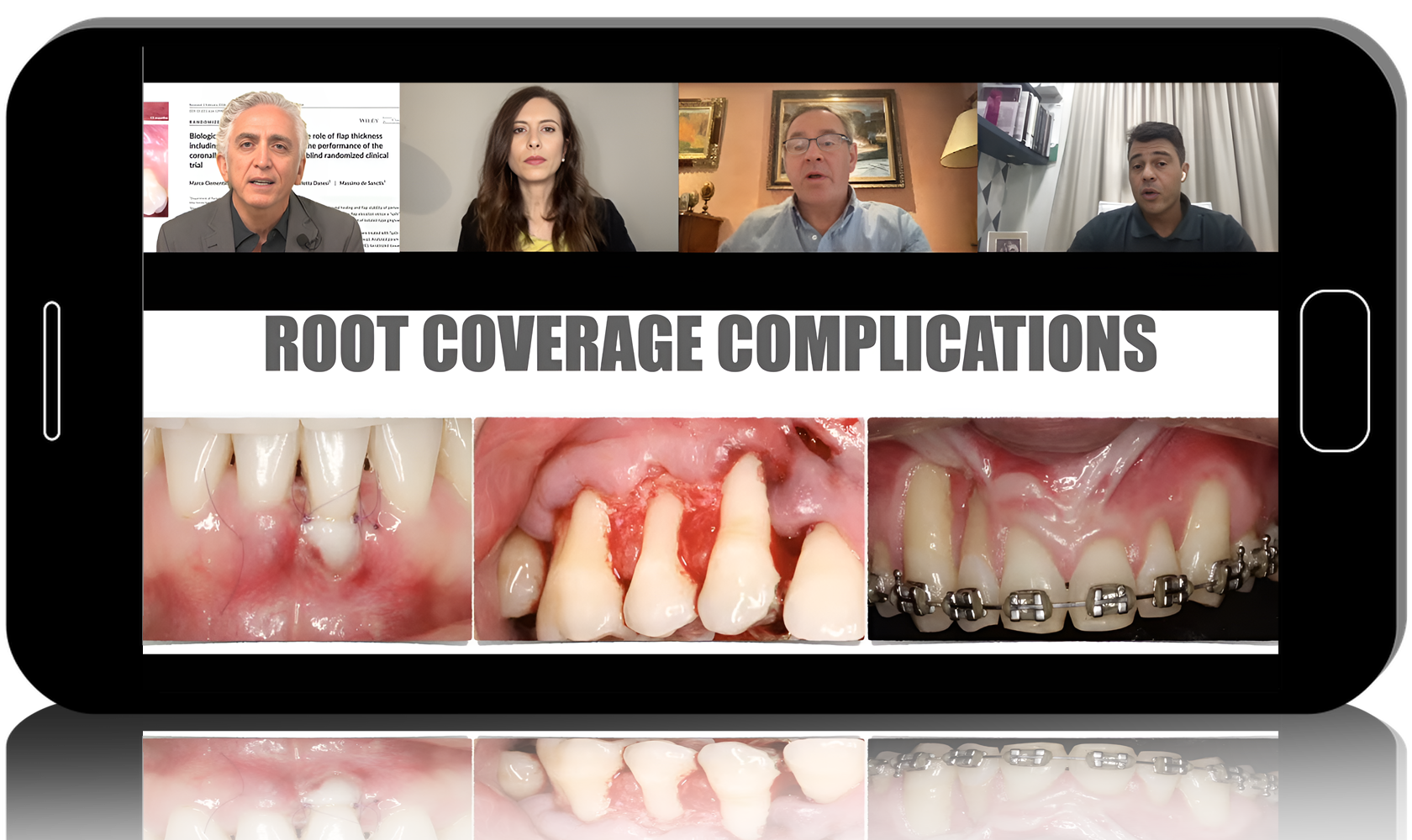Mucogingival surgery: root coverage protocols 2.0

Mucogingival surgery: root coverage protocols 2.0
7 lessons
Duration: 10 h 28 min
New protocols for surgical treatment of recession are presented in the course "Mucogingival surgery: root coverage protocols 2.0"!
During the training you will learn step-by-step the following protocols:
– Diagnosis and treatment planning of recession
– Treatment of single and multiple recession in the maxilla and mandible
– Work with connective tissue graft
– Flap techniques:
- envelope flap technique
- single incision technique
- L-incision technique.
– Tunnel techniques:
- author's VISTA technique.
-
1. Root coverage: treatment planning1 h 59 min
-
2. Root coverage: complications and pitfalls2 h
-
3. Treatment of maxillary localised gingival recession54 min
-
4. Diagnosis of gingival recession and determination of treatment tactics52 min
-
5. Harvesting technique for root coverage procedures1 h
-
6. Treatment of single and multiple gingival recessions2 h
-
7. Updated VISTA technique1 h 32 min
Lesson program
– Recessions: etiology and classification
– Root coverage: prognostic factors
– Tunnel techniques: technical features
– Criteria for successful treatment of recessions
– Indications for the use of a connective tissue graft
– The effect of Emdogain on periodontal tissue
– Connective tissue graft: donor zones
– Tunneling approach: demonstration of the methodology
– VISTA methodology: video demonstration
– The "Zipper technique"
– Techniques for closing multiple recessions.
Recommended for: Periodontists.
Lesson program
– Types of complications in the root coverage
– Root coverage success criteria
– Root coverage decision tree
– Surgical technical notes
– Prognostic factors to achieve predictable outcomes
– Indications for root coverage that appeared after orthodontic treatment
– Protocol for the xenograft using in root coverage
– Non carious cervical lesions: tactics
– CEY identification
– Methods for the phenotype of soft tissues evaluation
– Graft necrosis: reasons and tactics.
Recommended for: Periodontists.
Lesson program
– Classification of localised gingival recessions
– Diagnostics of the mucogingival lesions and planing their treatment to achieve the best possible outcomes
– Gingival recession lockalized in the maxilla: classification, diagnosis and treatment approaches
– Treatment standards for root coverage
– Using of autologous grafts in combination with the envelope technique for single tooth recession
– The tunnel technique for the treatment of multiple adjacent tooth recession: step-by-step protocol
– Coronally advanced flap: step-by-step protocol
– Technique of connective tissue graft sampling.
Recommended for: Periodontists.
Lesson program
– How to diagnose a gingival recession?
– Clinical and anatomical cement-enamel junction
– Non-carious cervical defects: associated with gingival recession
– Classification of gingival recession
– Prognosis of root coverage procedure
– How to determine the maximum root coverage achievable?
– Etiology of gingival recession
– Indications and goals for surgical treatment of gingival recession.
Recommended for: Periodontists.
Lesson program
– Palatal anatomy and its influence in choosing the proper harvesting technique
– Techniques available in the literature:
- trap door
- L-incision technique
- single incision technique.
– De-epithelialized free gingival graft technique: step-by-step surgical technique
– Advantages and disadvantages of different harvesting techniques
– Primary intention palatal wound healing
– Complication of the de-epithelialized free gingival graft technique.
Recommended for: Periodontists.
Lesson program
– Prognostic factors in the gingival recession treatment
– Coronally advanced flap in the treatment of single gingival recession: step-by-step surgical technique, indications and contraindications
– Coronally advanced flap (envelope flap) in the treatment of multiple gingival recession: step-by-step surgical technique, indications and contraindications
– When applying the connective tissue graft
– Connective tissue graft substitute.
Recommended for: Periodontists.
Lesson program
– History of concepts for management of gingival recession defects
– Periodontal phenotype
– Review of classic surgical techniques for the treatment of periodontal diseases
– Advantages of VISTA technique
– Mucosal split-thickness vs mucosal full-thickness flap
– Significance of periodontal phenotype in long-term stability of periodontal tissues
– Decision making on when phenotype modification therapy is necessary and whether augmentation of mucosa and/or alveolar bone augmentation is needed
– The VISTA protocol for phenotype modification therapy.
Recommended for: Periodontists, Implantologists, Oral and maxillofacial surgeons, General dentists.
Dr. Mariano Sanz
Dr. Robert Carvalho da Silva
Dr. Ilham Mounssif
-
Dr. Homa Zadeh
Dr. Zadeh is an Associate Professor at the USC School of Dentistry and a Diplomate of the American Board of Periodontology. He received his doctor of dental surgery degree from USC School of Dentistry in 1987. He has also completed advanced clinical education in Periodontology and earned a PhD degree in immunology from the University of Connecticut, Schools of Dental Medicine and Medicine. Dr. Zadeh directs the Laboratory for Immunoregulation and Tissue Engineering (LITE), funded by the National Institutes of Health. He has extensive publication track record and serves as editorial reviewer for several international scientific journals. He also serves on an advisory panel to the Center for Scientific Review of the National Institutes of Health. Dr. Zadeh is the Director of the USC Periodontal and Implant Symposium, and the USC Comprehensive Surgical and Restorative Implant Training Program. He also maintains a part-time private practice limited to Periodontology in Southern California.
-
Dr. Mariano Sanz
Mariano Sanz is professor and chair of periodontology at the University Complutense of Madrid (Spain) and a professor in the faculty of Odontology at the University of Oslo (Norway). He graduated in medicine in 1981 from the University Complutense of Madrid, from which he received a degree in stomatology in 1983 and where he qualified as a Doctor of Medicine in 1985. Prof Sanz has published 230 articles in scientific journals, written 50 book chapters, and has participated as an invited speaker at more than 200 scientific events in the last five years. He is an associate editor of the Journal of Clinical Periodontology and Evidence-Based Dental Practice and a member of the editorial boards of various other dental journals.
-
Dr. Robert Carvalho da Silva
Robert Carvalho da Silva received his dental degree from Uberlândia Federal University in 1994. Is board certificated in Periodontics at the Brazilian Dental Association/Brasília section in 1997, and completed his Master (2002) and PhD (2004) programs at Piracicaba Dental School/ Campinas University. He was the first recipient of the first edition of the e Bud Tarson award granted by the AAP (2005), and one of the winners of the “Growth Against Recession – Esthetic case competition” - esthetic case book (2011). He is also a professor at the ImplantePerio Institute - research and advanced dental training in São Paulo, and is author and co-author of several scientific publications and chapters in textbooks with emphasis on periodontal tissue management around teeth and implants. He is one of the authors of the book “Reconstrução Tecidual Estética” (2009) published in Portuguese, Spanish and Italian, and “PerioImplantodontia Estética”(2016) published in Portuguese, English and Spanish.
-
Dr. Ilham Mounssif
Professor of Periodontology and Implantology at the Bologna University. Member of the Italian Society of Periodontology (SIDP). Consultant in forensic dentistry. Author of numerous scientific papers on periodontology and implantology.

